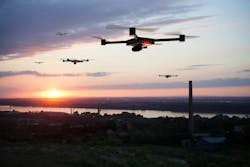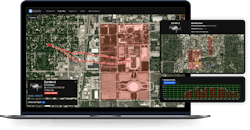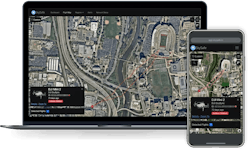Securing the Airspace: The Role of Drone Detection Technology in Law Enforcement
What to know
- Unauthorized drones threaten critical infrastructure, public safety, and privacy, necessitating advanced detection and response strategies.
- The partnership with Motorola Solutions enhances response capabilities by integrating drone data into command center operations, improving coordination.
- Legislation and technology are evolving to better regulate drone activity, with increased funding and stricter enforcement to address emerging threats.
More on OFFICER.com
Download the July/August issue of OFFICER Magazine.
Click Here to subscribe to OFFICER Magazine.
While many law enforcement agencies have turned to drones as tools to respond to emergencies, those same departments also are grappling with the challenge of tracking and addressing unauthorized drones in the airspace that can pose security threats.
Software companies, such as California-based SkySafe, are focused on developing solutions that help identify, track and analyze unauthorized drones. OFFICER Magazine recently reached out to Melissa Swisher, Chief Revenue Officer at SkySafe, who talked about the importance of drone detection technology and the company’s strategic alliance with Motorola Solutions.
How big of an issue is securing the local airspace for law enforcement agencies?
The rising drone activity is a serious concern for both local and federal governments due to the increasing risks posed to public safety and critical infrastructure. Unauthorized drones can disrupt operations at airports, power plants, water treatment facilities and even military bases. These incidents not only endanger lives but can also lead to significant economic and operational disruptions. Governments and law enforcement agencies are under pressure to address these threats while managing the growing adoption of drones in legitimate industries.
What are some of the threats drones with unauthorized access pose?
The dangers of drones are wide-ranging. Unauthorized drones can be used for espionage, and weaponized to damage power grids, disrupt airspace, endanger aircraft, jeopardize public events, smuggle contraband into secure facilities, and deliver harmful payloads. They also pose a surveillance risk, potentially violating individual privacy and compromising sensitive operations or infrastructure.
What was the traditional way of detecting and stopping unauthorized drones?
Traditionally, drones were identified using the human eye. However, this method has significant limitations. Drones are small and easily mistaken for birds or distant aircraft, while their operators may be located miles away from the drone itself. These factors create numerous unknowns, making it even harder to assess the threat and making reliable detection even more challenging.
How does SkySafe help law enforcement agencies not only detect drones, but also help prevent them from being there in the first place?
SkySafe’s cloud-based drone detection technology provides law enforcement agencies with a comprehensive solution for airspace management. Its system addresses the escalating challenge of enforcing drone ordinances while significantly enhancing safety across critical sites. The system enables the agency officials to identify, track, and gather drone data in real time and then map current activity against historical data, revealing crucial patterns and trends. In addition to these real-time alerts, SkySafe delivers in-depth drone forensics, including the drone’s full flight history. This detailed forensic analysis enables law enforcement agencies to address and prosecute any unauthorized drone activity.
What steps can law enforcement agencies take once an unauthorized drone is detected?
Law enforcement agencies can act in real-time and leverage the data and forensics it gathers from SkySafe with enough information to address and prosecute any unauthorized drone activity.
A great example of this was during a sold-out game at the University of Illinois, a drone breached the stadium’s airspace, hovering ominously over the 50-yard line. SkySafe’s comprehensive solution instantly pinpointed the operator’s location: a fourth-floor balcony half a mile away. Within minutes, officers located and apprehended the operator. Having a real-time response prevented what could have escalated into a more serious drone attack.
Then, using SkySafe’s forensic data, police confirmed the drone’s flight path and no-fly zone violation. The data also revealed the operator’s history of reckless behavior, including flights over densely populated campus events. The operator was charged with reckless conduct under Illinois state law, and the case was forwarded to the FAA. The arrest and prosecution set a precedent for campus drone enforcement and demonstrated the practical value of SkySafe’s drone forensic capabilities.
What has the feedback been from law enforcement agencies that use SkySafe?
SkySafe has become an integral part in their comprehensive security approach and helps them scale their efforts. Some have even leveraged data from SkySafe to demonstrate the critical need for enhanced airspace monitoring and secure additional funding for drone defense. Here is a quote from John Washburn, Associate Director, Operations at the State of Rhode Island’s Emergency Management Agency: “Before SkySafe, it was all boots on the ground—someone spotting a drone and hoping to track it down. Now we can see where it launched, how high it went, how long it flew, and where it flew from. It’s completely changed how we approach airspace security.”
As technology and legislation continues to advance, how will drone detection evolve?
A comprehensive strategy is essential. This includes implementing advanced detection and monitoring technologies, like SkySafe, to provide real-time visibility. Also, we need to establish and enforce robust alert and no-fly zones around sensitivities. We need to train infrastructure operators and security personnel to recognize and respond to potential drone threats. By strengthening public-private partnerships, we can share intelligence and coordinate responses to unauthorized drone activity.
As drone use continues to expand and technology advances, it’s clear that our laws need to keep up with the new risks that come with it. In fact, the current administration signed two sweeping executive orders aimed at regaining control of American airspace and confronting growing drone threats head on, including approving $500 million specifically for state and local agencies to improve their ability to detect, identify, and monitor unmanned aircraft systems (UAS). From this, we expect to see stronger regulations at both the state and federal levels, including tighter licensing requirements, stricter operational limits, and tougher penalties for misuse. That said, it’s important to strike a balance — regulations shouldn’t hold back the incredible benefits drones bring. At SkySafe, we’re dedicated to partnering with governments and industry leaders to create policies that prioritize safety.
How does the strategic alliance with Motorola Solutions help SkySafe’s overall mission?
As part of the strategic alliance, Motorola Solutions will integrate SkySafe’s counter-drone detection into its command center software to help 9-1-1 and command center operators optimize response. For example, real-time drone detection near critical infrastructure could trigger an alert and identify a drone’s threat level, location and flight path while automatically cross-referencing with other existing incident data. Dispatchers could share this information with first responders in the field, enabling a more comprehensive and faster response.
The alliance will provide a solution to law enforcement and public safety agencies seeking increased drone detection and tracking capabilities, and to organizations that need to know the location of their own drones.
About the Author
Paul Peluso
Editor
Paul Peluso is the Managing Editor of OFFICER Magazine and has been with the Officer Media Group since 2006. He began as an Associate Editor, writing and editing content for Officer.com. Previously, Paul worked as a reporter for several newspapers in the suburbs of Baltimore, MD.




